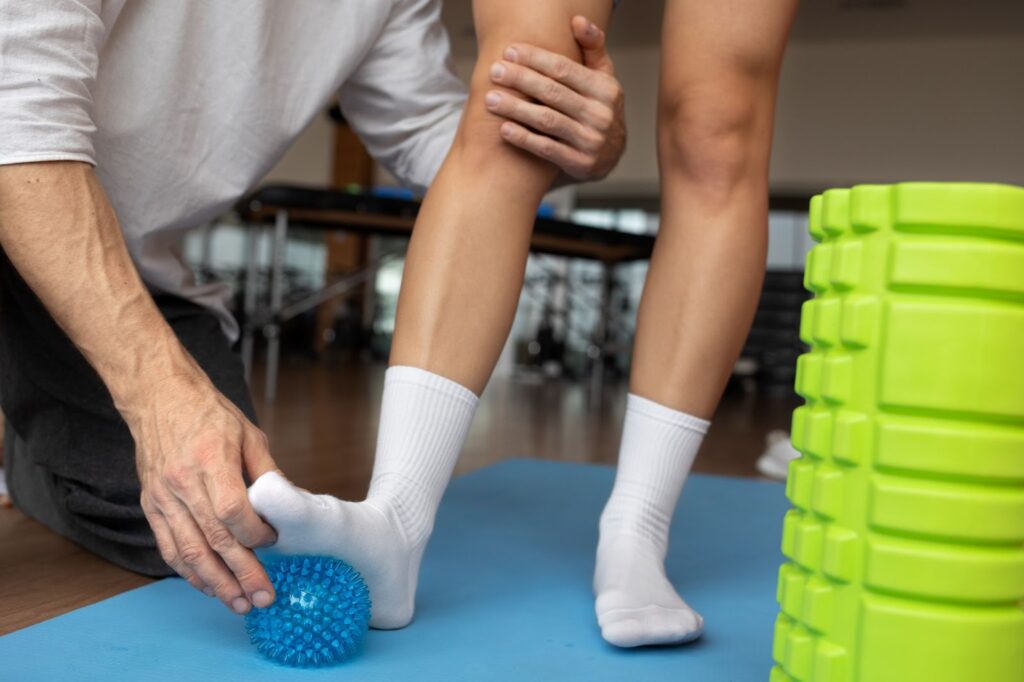This article is intended for both patients and healthcare professionals. It focuses on the relationship between hallux valgus and index minus—two often-associated yet not always well-understood clinical elements. For further reading, visit specialized resources like infochirpied.fr
Hallux valgus, commonly referred to as a “bunion,” is much more than a simple cosmetic foot deformity. Characterized by the lateral deviation of the big toe, it affects a large segment of the population—especially women (with four times more cases than men). It can cause pain, difficulty walking, and problems wearing shoes. In some cases, it makes sports or physical activity difficult, painful, or even impossible. As the condition progresses, it deforms shoes and ultimately impairs quality of life.
To understand this condition, it is useful to look beyond just the big toe and consider the second toe, which plays a key role—alongside the big toe—in the foot’s balance and dynamic function.
Imagine your foot as a sports team, with each toe playing a specific role. The big toe is the leader, bearing most of the body’s weight and helping propel the body forward. The second toe is the co-player that stabilizes the foot and redistributes forces to make every step efficient and comfortable.
In a healthy foot, this partnership is harmonious and well-coordinated. But with hallux valgus, the big toe deviates outward, disrupting the team’s synergy. The second toe gets trapped between the big toe and the third toe and has to compensate for the deformity. This overload can lead to pain and/or slight secondary deformity.

What Is Index Minus?
There are three main forefoot morphotypes:
- Egyptian foot: the big toe is longer than the other toes (seen in 50–60% of the population, though this varies by country)
- Greek foot: the second toe is longer than the big toe (about 10–15%, more common in countries like France and Greece)
- Square foot: the big toe and the second toe are approximately the same length
Some sources also mention subtypes such as Roman, Celtic, and Germanic morphotypes. These distinctions are thought to be inspired by representations of feet in ancient statues. For example, Greek sculptures typically show a shorter big toe, whereas Egyptian statues depict a longer one. Some authors even suggest that the prevalence of the “Greek” foot type is indeed higher in Greek populations.
Definition and Role of Index Minus
When there is excessive pressure on the metatarsal heads, the line connecting the heads of the lateral metatarsals lies further forward than that of the first metatarsal. The alignment of the metatarsophalangeal joints is then assessed using the metatarsal index. In this configuration, we speak of an “index minus.”
In the presence of an index minus, the second toe plays a crucial role—even if it appears less dominant than the first. It is essential to the foot’s overall stability and functionality. It also helps distribute forces during walking or running. As such, it absorbs impacts and helps preserve the structural integrity of the foot.
Beyond its mechanical role, the second toe has significant sensory importance. This area is highly innervated, capable of detecting subtle variations in ground pressure and texture. This sensitivity enables the foot to adjust automatically, supporting better coordination during gait.
Thanks to its dense network of nerve receptors, the body receives real-time feedback, allowing it to adjust posture instantly. This promotes a more stable and secure gait.

The Second Toe: A Sensory Sensor and Key Stabilizer
The collaboration between the big toe and the second toe is essential for balanced weight distribution. While the big toe provides propulsion by bearing most of the load, the second toe contributes to foot stabilization and shock absorption. When this coordination is disrupted—as in hallux valgus—the second toe must endure increased pressure. Over time, this can lead to pain and progressive functional decline.
Understanding this interdependence is crucial for implementing effective prevention and treatment strategies that address the biomechanics of the entire foot.
A Closer Look at the Second Toe: Simplified Anatomy
- Structure: The second toe consists of small bones called phalanges, joined together and connected to the foot by a joint.
- Function: It contributes to foot flexibility and helps adapt to variations in terrain.
- Muscular and Neural Support: Surrounding the toe are muscles, tendons, and ligaments that ensure its movement and stability. A dense neural network allows the toe to detect and adjust to pressure during weight-bearing.
Hallux Valgus and Its Consequences on Index Minus
Sports Analogy:
Imagine your team leader suddenly changes direction. The rest of the team must adjust to maintain balance. Similarly, when the big toe deviates, the second and other toes must adapt to preserve foot stability.
Consequences:
- Redistribution of Forces: The foot attempts to compensate for the loss of stability caused by hallux valgus. The second toe then absorbs more pressure with every step.
- Risk of Secondary Deformation: Over time, this overload can cause mild deformation or pain in the second toe due to repeated microtrauma.
- Gait Disruption: Coordination between the big toe and index minus is essential for smooth walking. When this balance is disrupted, gait becomes less natural and can lead to increased muscular fatigue.
Clinical and radiographic studies confirm this relationship: the greater the deviation of the big toe, the more often the second toe is affected. This highlights the importance of a comprehensive foot evaluation when diagnosing hallux valgus.
Therapeutic Approaches
Conservative and Preventive Treatments
Before considering surgery, several conservative strategies can be implemented to slow the progression of hallux valgus and protect the index minus:
- Choosing the Right Footwear: Wearing wide shoes with a roomy toe box, good arch support, and moderate heels can be very helpful. Going up one shoe size can significantly reduce forefoot pressure. Avoid rigid leather; instead, choose soft materials like suede, nubuck, or canvas.
- Use of Orthotics and Custom Insoles: Custom-made plantar orthotics help redistribute pressure and stabilize toe alignment. They are especially beneficial for relieving the second toe (index minus) when it is overloaded.
- Physical Therapy and Specific Exercises: Physical therapy plays a crucial role. Targeted exercises focusing on muscle strengthening, stretching, and proprioception (the body’s sense of position and movement) help maintain foot balance and improve gait efficiency.
Surgical Treatment: Two Main Approaches
When conservative treatments no longer relieve pain or correct the deformity, surgery may be considered.
Every surgical treatment shortens the first metatarsal. In the presence of an index minus, this can worsen the imbalance by increasing the load on the second metatarsal. This leads to “transfer metatarsalgia” and often to the development of a plantar callus. Two main surgical techniques are commonly used, each with specific drawbacks that can be amplified by the complexity of index minus. In practice, both approaches often yield comparable results.
Open Surgery
- Principle: A large incision is made to expose the bone and soft tissues, allowing for precise correction of the deformity.
- Advantages: Direct and complete correction of the deformity.
- Disadvantages: Longer recovery time and a higher risk of skin complications and infection.
Percutaneous (Minimally Invasive) Surgery
- Principle: Small incisions are made, and the correction is performed using specialized tools and real-time radiographic guidance.
- Advantages: Less tissue trauma, faster recovery, and more discreet scarring.
- Disadvantages: Requires specific technical expertise and careful patient selection.
It is essential to note that surgical correction should not be limited to realigning the big toe. To avoid persistent overload, the alignment of the second metatarsal—and the entire foot—must be considered in surgical planning.
Advances in Technology and Practical Advice
Recent advances in 3D imaging and computer-assisted preoperative planning represent a true revolution in foot surgery. These tools now allow for procedures to be tailored to each patient’s unique anatomy, offering enhanced precision and facilitating the surgical act. Furthermore, techniques such as robotic surgery or arthroscopy to treat associated lesions open up new possibilities. These innovations aim to improve postoperative outcomes and reduce the risk of complications.
Practical Tips and Recommendations
To limit the progression of hallux valgus and its consequences, and to avoid transfer metatarsalgia, here are some simple recommendations:
- Choose proper footwear: Opt for wide-toe models with moderate heels.
- Use orthopedic insoles: Custom-made versions help redistribute pressure across the foot.
- Perform regular exercises: Strengthen foot muscles and improve balance with physical therapy.
- Monitor your symptoms: In case of pain or deformity, consult a specialist early to avoid worsening.
To learn more about preventing and treating hallux valgus, visit expert websites like infochirpied.fr, which offer practical advice, patient testimonials, and up-to-date information on both surgical and conservative treatments.
FAQ – Hallux Valgus and Index Minus
Q: When should hallux valgus surgery be considered?
A: Surgery is recommended when conservative treatments—such as orthotics, rehabilitation, or footwear adjustments—no longer provide relief. If symptoms persist or the deformity continues to progress, surgery becomes necessary. It helps realign the big toe, reduces pressure on the index minus, relieves pain, and restores proper foot function.
Q: What are the surgical options for treating hallux valgus?
A: There are two main options:
- Open surgery, which gives complete access to the deformed structures for precise correction
- Percutaneous (minimally invasive) surgery, which is less invasive and allows faster recovery Both aim to reduce hallux valgus pain and restore balanced weight distribution across the foot.
Q: Is hallux valgus surgery effective in relieving pain?
A: Yes, in many cases, surgery corrects the toe deviation and significantly reduces pain. However, it is essential to follow postoperative care instructions and complete rehabilitation to optimize outcomes and prevent recurrence.
Q: What if pain persists after hallux valgus surgery?
A: If pain continues after surgery, it is important to consult your specialist again. Additional conservative treatments or a revision surgery may be needed to improve comfort and fully restore foot function.
Q: Is hallux valgus always painful?
A: Often, yes. The deviation causes excess pressure on the bunion area and alters force distribution in the foot. This can result in localized pain during walking and daily activities, along with discomfort that impacts overall mobility. Pain may also extend to the index minus and surrounding structures due to compensatory overuse.
